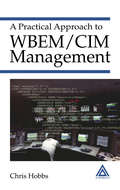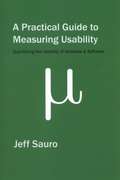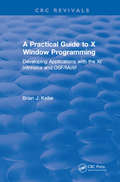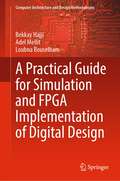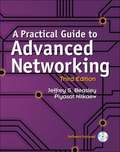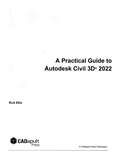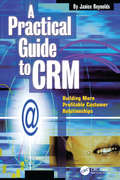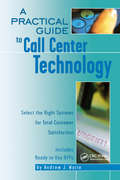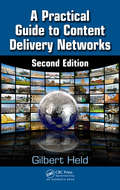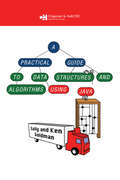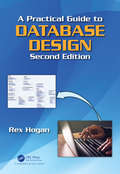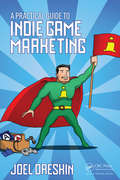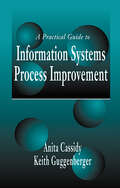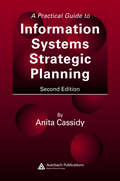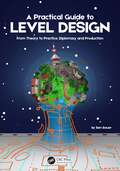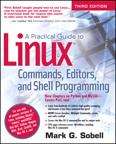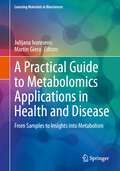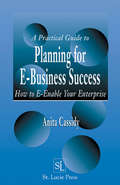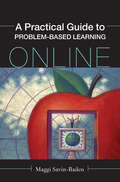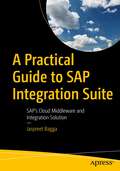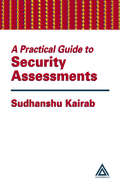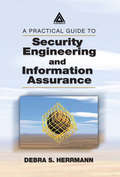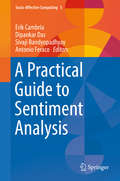- Table View
- List View
A Practical Approach to WBEM/CIM Management
by Chris HobbsSystem architects and engineers in fields such as storage networking, desktop computing, electrical power distribution, and telecommunications need a common and flexible way of managing heterogeneous devices and services. Web-Based Enterprise Management (WBEM) and its Component Information Model (CIM) provide the architecture, language, interfaces,
A Practical Guide To Measuring Usability: 72 Answers To The Most Common Questions About Quantifying The Usability Of Websites And Software
by Jeff SauroA detailed and readable guide that answers the most common questions that arise when measuring the usability of websites, software or cellphones. What measures do you take? What do have users do? What questionnaires do you use? What about sample size and statistical analysis?
A Practical Guide To X Window Programming: Developing Applications with the XT Intrinsics and OSF/Motif
by Brian J. KellerA Practical Guide to X Window Programming is a basic guide that takes readers step by step through developing applications using X-Windows. The book covers the Xt Intrinsics portion of the X-Window system in detail and discusses the MIT Athena and OSF/Motif Widget Sets that are used in many of the examples. Topics covered include C programming fundamentals, text handling using X, fonts, event handling in Xt, extending the Widget Sets (building on Field Editor Widget), designing and constructing an application, building menus, printing help, OSF/Motif (including the window arranger) and interclient communication. Three extensive appendices are included: Widgets, Classing, and Exported Functions; Quick Xt Reference Guide (X11R4); and Quick Guide to OSF/Motif Widgets. Any applications designer interested in developing applications with Xt will find this book a valuable and enlightening resource.
A Practical Guide for Simulation and FPGA Implementation of Digital Design (Computer Architecture and Design Methodologies)
by Bekkay Hajji Adel Mellit Loubna BouselhamThis book introduces the FPGA technology used in the laboratory sessions, and provides a step-by-step guide for designing and simulation of digital circuits. It utilizes the VHDL language, which is one of the most common language used to describe the design of digital systems. The Quartus II, Xilinx ISE 14.7 and ModelSim software are used to process the VHDL code and make simulations, and then the Altera and Xilinx FPGA platforms are employed to implement the simulated digital designs. The book is composed of four parts. The first part of this book has two chapters and covers various aspects: FPGA architectures, ASIC vs FPGA comparison, FPGA design flow and basic VHDL concepts necessary to describe the design of digital systems. The second part of the book includes three chapters that deal with the design of digital circuits such as combinational logic circuits, sequential logic circuits and finite state machines. The third part of the book is reserved for laboratory projects carried out on the FPGA platform. It is a largely hands-on lab class for design digital circuits and implementing their designs on the Altera FPGA platform. Finally, the fourth part of this work is devoted to recent applications carried out on FPGAs, in particular advanced techniques in renewable energy systems. The book is primarily intended for students, scholars, and industrial practitioners interested in the design of modern digital systems.
A Practical Guide to Advanced Networking
by Jeffrey S. Beasley Piyasat NilkaewA Practical Guide to Advanced Networking, Third Edition takes a pragmatic, hands-on approach to teaching advanced modern networking concepts from the network administrator’s point of view. Thoroughly updated for the latest networking technologies and applications, the book guides you through designing, configuring, and managing campus networks, connecting networks to the Internet, and using the latest networking technologies.
A Practical Guide to AutoCAD 2025
by Rick Ellis Tracy ChadwickCongratulations on choosing this course to help you learn how to use AutoCAD 2025. The term “practical” is used in the title because this course focuses on what you need to effectively use AutoCAD 2025, and does not complicate your learning experience with unnecessary details of every feature in the product. Should you want to pursue aspects of features and functionality in greater detail than provided in this course, you are directed and guided to that information. Each lesson contains the concepts and principles of each feature to provide you with the background and foundation of knowledge that you need to complete the lesson. You then work through exercises to reinforce your understanding and provide you with practice on common tasks that other professionals are performing with AutoCAD 2025 in the workplace every day.
A Practical Guide to CRM: Building More Profitable Customer Relationships
by Janice ReynoldsIn today's global economy the customer has more and better choices than ever before, bringing on one of the biggest challenges the business community faces today - customer loyalty and retention. To thrive in today's customer-driven economy a company need
A Practical Guide to Call Center Technology: Select the Right Systems for Total Customer Satisfaction
by Andrew WaiteGet the most out of ACDs (automatic call distributors) and other complex systems in order to boost customer satisfaction and increase sales Includes three ready to use RFPs (request for proposals) for buying an ACD, computer telephony system, or recording
A Practical Guide to Content Delivery Networks
by Gilbert HeldFollowing in the tradition of its popular predecessor, A Practical Guide to Content Delivery Networks, Second Edition offers an accessible and organized approach to implementing networks capable of handling the increasing data requirements of today's always on mobile society. Describing how content delivery networks (CDN) function, it provides
A Practical Guide to Data Structures and Algorithms using Java (Chapman & Hall/CRC Applied Algorithms and Data Structures series)
by Sally. A Goldman Kenneth. J GoldmanAlthough traditional texts present isolated algorithms and data structures, they do not provide a unifying structure and offer little guidance on how to appropriately select among them. Furthermore, these texts furnish little, if any, source code and leave many of the more difficult aspects of the implementation as exercises. A fresh alternative to
A Practical Guide to Database Design (Second Edition)
by Rex HoganFully updated and expanded from the previous edition, A Practical Guide to Database Design, Second Edition, is intended for those involved in the design or development of a database system or application. It begins by focusing on how to create a logical data model where data is stored "where it belongs." Next, data usage is reviewed to transform the logical model into a physical data model that will satisfy user performance requirements. Finally, it describes how to use various software tools to create user interfaces to review and update data in a database. Organized into 11 chapters, the book begins with an overview of the functionality of database management systems and how they guarantee the accuracy and availability of data. It then describes how to define and normalize data requirements to create a logical data model, then map them into an initial solution for a physical database. The book next presents how to use an industry-leading data modeling tool to define and manage logical and physical data models. After that, it describes how to implement a physical database using either Microsoft Access or SQL Server and how to use Microsoft Access to create windows interfaces to query or update data in tables. The last part of the book reviews software tools and explores the design and implementation of a database using as an example a much more complex data environment for a University. The book ends with a description of how to use PHP to build a web-based interface to review and update data in a database.
A Practical Guide to Indie Game Marketing
by Joel DreskinLearn how to market for your indie game, even with a small budget and limited resources. <P><P>For those who want to earn a regular income from making indie games, marketing can be nearly as vital to the success of the game as the game itself. A Practical Guide to Indie Game Marketing provides you with the tools needed to build visibility and sell your game. With special focus on developers with small budgets and limited staff and resources, this book is packed with recommendations and techniques that you can put to use immediately. As a seasoned marketing professional, author Joel Dreskin provides insight into practical, real-world experiences from marketing numerous successful games and also shares tips on mistakes to avoid. Presented in an easy to read format, A Practical Guide to Indie Game Marketing includes information on establishing an audience and increasing visibility so you can build successes with your studio and games. <P><P>Through case studies, examples, guidelines and tips, you will learn best practices for developing plans for your game launches, PR, community engagement, channel promotions and more <P><P>Sample timelines help you determine how long in advance of a launch to prepare your first public communications, when to announce your game, as well as recommended timing for releasing different game assets <P><P>Book also includes marketing checklist 'cheat sheets', dos and don’ts and additional resources
A Practical Guide to Information Systems Process Improvement
by Anita Cassidy Keith GuggenbergerWhen you invest in expensive technology and systems, you want to get the most out of them. Process improvement has been used for years as an effective strategy to reduce costs, shorten cycle times, improve quality, and increase user satisfaction in other areas of business such as Quality, Manufacturing, and Engineering. While there are many books a
A Practical Guide to Information Systems Strategic Planning
by Anita CassidyThe foundation of a successful information systems strategic plan is the recognition that business direction and requirements must drive the IS strategy and computing architecture. A Practical Guide to Information Systems Strategic Planning, Second Edition outlines a systematic approach to guide you through the development of an effective IS plan t
A Practical Guide to Level Design: From Theory to Practice, Diplomacy and Production
by Benjamin BauerWritten by an AAA industry expert with over 20 years of experience, this book offers comprehensive coverage of the practical skills that all successful level designers need to have. It covers everything from practical production skills to the social and soft skills required to thrive in the gaming industry. This book begins with a theoretical and abstract approach that sets a common language for the later hard skill applications and practical examples. These later chapters cover a wealth of practical skills for use during the concept phase, while creating layouts, scripting, and working with AI. This book includes essential chapters on topics such as social skills, soft skills, world-building, level design direction, production, as well as how to gain employment in the industry. This book will be of great interest to all level designers, content leads, and directors looking to enhance their skillset. It will also appeal to students of level and game design looking for tips on how to break into the industry.
A Practical Guide to Linux Commands, Editors, and Shell Programming
by Mark G. Sobell"First Sobell taught people how to use Linux . . now he teaches you the power of Linux. A must-have book for anyone who wants to take Linux to the next level. " -Jon "maddog" Hall, Executive Director, Linux International New Chapters on Python and MySQL-Covers Perl, too! Learn from hundreds of realistic, high-quality examples, and become a true Linux command-line guru! NEW! Covers busybox, Midnight Commander, screen, and sshfs/curlftpf Covers the Mac OS X command line and its unique tools 295-page reference covers 98 utilities, including Mac OS X commands! For use with all popular versions of Linux, including Ubuntu(tm), Fedora(tm), openSUSE(tm), Red Hat®, Debian, Mageia, Mint, Arch, CentOS, and Mac OS X, too! The Most Useful Tutorial and Reference, with Hundreds of High-Quality Examples for Every Popular Linux Distribution Linux is today''s dominant Internet server platform. System administrators and Web developers need deep Linux fluency, including expert knowledge of shells and the command line. This is the only guide with everything you need to achieve that level of Linux mastery. Renowned Linux expert Mark Sobell has brought together comprehensive, insightful guidance on the tools sysadmins, developers, and power users need most, and has created an outstanding day-to-day reference. This title is 100 percent distribution and release agnostic. Packed with hundreds of high-quality, realistic examples, it presents Linux from the ground up: the clearest explanations and most useful information about everything from filesystems to shells, editors to utilities, and programming tools to regular expressions. Use a Mac? You''ll find coverage of the Mac OS X command line, including OS X-only tools and utilities other Linux/UNIX titles ignore. Sobell presents a new MySQL chapter. There''s even an expert introduction to Python-today''s most valuable tool for automating complex, time-consuming administration tasks. A Practical Guide to Linux® Commands, Editors, and Shell Programming, Third Edition, is the only guide to deliver A MySQL chapter to get you started with this ubiquitous relational database management system (RDBMS) A masterful introduction to Python for system administrators and power users New coverage of the busybox single binary collection of utilities, the screen terminal session manager/multiplexer, and the mc (Midnight Commander) textual file manager, plus a new chapter on using ssh for secure communication In-depth coverage of the bash and tcsh shells, including a complete discussion of environment, inheritance, and process locality, plus coverage of basic and advanced shell programming Practical explanations of 98 core utilities, from aspell to xargs, including printf and sshfs/curlftpfs, PLUS Mac OS X-specific utilities from ditto to SetFile Expert guidance on automating remote backups using rsync Dozens of system security tips, including step-by-step walkthroughs of implementing secure communications using ssh and scp Tips and tricks for customizing the shell, including step values, sequence expressions, the eval builtin, and implicit command-line continuation High-productivity editing techniques using vim and emacs A comprehensive, 295-page command reference section covering 98 utilities, including find, grep, sort, and tar Instructions for updating systems using apt-get and yum And much more, including coverage of BitTorrent, gawk, sed, find, sort, bzip2, and regular expressions.
A Practical Guide to Metabolomics Applications in Health and Disease: From Samples to Insights into Metabolism (Learning Materials in Biosciences)
by Martin Giera Julijana IvanisevicThis well-accessible textbook constitutes a practical guide to metabolomics approaches and applications in an integrative manner. Illustrated by numerous real-life examples and case studies the book teaches how to set up and carry out metabolomics experiments, from sample collection to storage techniques, and guides the reader through the potentials and challenges of metabolite analysis. In addition, this textbook shows how to obtain insights into molecular mechanisms deployed in different physiological contexts (e.g., exercise, healthy ageing) as well as in different (metabolic) diseases, be it Diabetes, Cancer, Alzheimer´s Disease, Asthma or others. The book brings together knowledge from biochemical, biological, and medical aspects, and further equips the reader with know-how from sample collection and handling to data processing, analysis and interpretation. This textbook is a must-have for advanced undergraduates and graduate students interested in applied biochemistry and metabolomics, as well as for instructors who teach courses in biomedicine, physiology or biochemistry.
A Practical Guide to Planning for E-Business Success: How to E-enable Your Enterprise
by Anita CassidyNews of the Web's demise has been greatly exaggerated. The Internet continues to impact our lives and how we do business. It has the power to transform entire industries and create new ones, challenge industry leaders, and enable businesses in entirely new ways. The question is no longer will you participate in the Internet revolution, but when and
A Practical Guide to Problem-Based Learning Online
by Maggi Savin-BadenProblem-based learning online is a burgeoning area, crying out for support in all the disciplines, but particularly health, medicine, education and social care that are already advanced users of problem-based learning in higher education. This book provides highly grounded research based ways for those wanting to change problem-based learning modules and programs from face to face to online approaches, as well as those who have developed e-learning components but who want to adopt problem-based methods. Providing an overview of the current state of problem based learning online, it examines why we're moving from fact to face to online provision, considers existing forms of provision, outlines common mistakes and strategies to avoid future problems, and shows how to effectively facilitate learning. Illustrated by mini case studies and examples of international projects, it provides guidance on effective design, online collaboration and group dynamics, and explores the common, and complex, decisions faced when choosing which form of problem-based learning to adopt. Including practical information and resources for games and activities, scenarios of problem-based learning in the different disciplines, advice for supporting staff and students, and effectively evaluating the tools, skills and pedagogy needed for learning, this book is an essential guide for all practitioners involved in the design and delivery of problem based learning online.
A Practical Guide to SAP Integration Suite: SAP’s Cloud Middleware and Integration Solution
by Jaspreet BaggaThis book covers the basics of SAP’s Integration Suite, including a broad overview of its capabilities, installation, and real-life examples to illustrate how it can be used to integrate, develop, administer, and monitor applications in the cloud.As you progress through the book, you will see how SAP Integration Suite works as an open, enterprise-grade platform that is a fully vendor-managed, multi-cloud offering that will help you expedite your SAP and third-party integration scenarios. The entire value chain is explored in detail, including usage of APIs and runtime control.Author Jaspreet Bagga demonstrates how SAP’s prebuilt integration packages facilitate quicker, more comprehensive integrations, and how they support a variety of integration patterns. You’ll learn how to leverage the platform to enable seamless cloud and on-premises applications connectivity, develop custom scenarios, mix master data, blend business-to-business (B2B) and electronic data interchange (EDI) processes, including trading partner management. Also covered are business-to-government (B2G) scenarios, orchestrating data and pipelines, and mixing event-driven integration. Upon completing this book, you will have a thorough understanding of why SAP Integration Suite is the middleware of SAP’s integration strategy, and be able to effectively use it in your own integration scenarios.What You Will LearnUnderstand SAP Integration Suite and its core capabilitiesKnow how integration technologies, such as architecture and supplementary intelligent technologies, work within the SAP Integration SuiteDiscover services for pre-packaged accelerators: SAP API Management, the Integration Advisor, and the SAP API Business HubUtilize integration features to link your on-premises or cloud-based systemsUnderstand the capabilities of the newly released Migration AssessmentWho This Book Is forWeb developers and application leads who want to learn SAP Integration Suite.
A Practical Guide to Security Assessments
by Sudhanshu KairabThe modern dependence upon information technology and the corresponding information security regulations and requirements force companies to evaluate the security of their core business processes, mission critical data, and supporting IT environment. Combine this with a slowdown in IT spending resulting in justifications of every purchase, and security professionals are forced to scramble to find comprehensive and effective ways to assess their environment in order to discover and prioritize vulnerabilities, and to develop cost-effective solutions that show benefit to the business. A Practical Guide to Security Assessments is a process-focused approach that presents a structured methodology for conducting assessments. The key element of the methodology is an understanding of business goals and processes, and how security measures are aligned with business risks. The guide also emphasizes that resulting security recommendations should be cost-effective and commensurate with the security risk. The methodology described serves as a foundation for building and maintaining an information security program. In addition to the methodology, the book includes an Appendix that contains questionnaires that can be modified and used to conduct security assessments. This guide is for security professionals who can immediately apply the methodology on the job, and also benefits management who can use the methodology to better understand information security and identify areas for improvement.
A Practical Guide to Security Engineering and Information Assurance
by Debra S. HerrmannToday the vast majority of the world's information resides in, is derived from, and is exchanged among multiple automated systems. Critical decisions are made, and critical action is taken based on information from these systems. Therefore, the information must be accurate, correct, and timely, and be manipulated, stored, retrieved, and exchanged s
A Practical Guide to Sentiment Analysis (Socio-Affective Computing #5)
by Erik Cambria Dipankar Das Sivaji Bandyopadhyay Antonio FeracoSentiment analysis research has been started long back and recently it is one of the demanding research topics. Research activities on Sentiment Analysis in natural language texts and other media are gaining ground with full swing. But, till date, no concise set of factors has been yet defined that really affects how writers' sentiment i. e. , broadly human sentiment is expressed, perceived, recognized, processed, and interpreted in natural languages. The existing reported solutions or the available systems are still far from perfect or fail to meet the satisfaction level of the end users. The reasons may be that there are dozens of conceptual rules that govern sentiment and even there are possibly unlimited clues that can convey these concepts from realization to practical implementation. Therefore, the main aim of this book is to provide a feasible research platform to our ambitious researchers towards developing the practical solutions that will be indeed beneficial for our society, business and future researches as well.
A Practical Guide to TPM 2.0: Using the Trusted Platform Module in the New Age of Security
by Will Arthur David Challener Kenneth GoldmanA Practical Guide to TPM 2. 0: Using the Trusted Platform Module in the New Age of Security is a straight-forward primer for developers. It shows security and TPM concepts, demonstrating their use in real applications that the reader can try out. Simply put, this book is designed to empower and excite the programming community to go out and do cool things with the TPM. The approach is to ramp the reader up quickly and keep their interest. A Practical Guide to TPM 2. 0: Using the Trusted Platform Module in the New Age of Security explains security concepts, describes the TPM 2. 0 architecture, and provides code and pseudo-code examples in parallel, from very simple concepts and code to highly complex concepts and pseudo-code. The book includes instructions for the available execution environments and real code examples to get readers up and talking to the TPM quickly. The authors then help the users expand on that with pseudo-code descriptions of useful applications using the TPM. What you'll learn TPM 2. 0 architecture fundamentals, including changes from TPM 1. 2 TPM 2. 0 security concepts Essential application development techniques A deep dive into the features of TPM 2. 0 A primer on the execution environments available for application development. Learn as you go! Who this book is for Application software developers, OS developers, device-driver developers, and embedded-device specialists, who will benefit from mastering TPM 2. 0 capabilities and building their own applications quickly. This book will give them the tools they need to experiment with and understand the technology. Software architects who need to understand the security guarantees provided by TPMs Managers who fund the projects that use TPMs. Non-technical users who may want to know why TPMs are on their computers and how to make use of them. Table of Contents Foreword Preface Chapter 1: Overview Chapter 2: Security Concepts for Dummies Chapter 3: Quick tutorial on TPM 2. 0 Chapter 4: Existing Applications that make use of TPMs Chapter 5: Navigating the spec Chapter 6: Execution Environment Chapter 7: TPM software stack (TSS) Chapter 8: Intro to TPM Entities Chapter 9: Hierarchies Chapter 10: Keys Chapter 11: NV Indices Chapter 12: PCRs and Attestation Chapter 13: Authorizations and Sessions Chapter 14: EA (Policy Authorizations) Chapter 15: Key management Chapter 16: Audit Chapter 17: Encrypt/Decrypt Chapter 18: Object and Session Management Chapter 19: TPM Startup and Provisioning Chapter 20: How to debug TPM 2. 0 applications Chapter 21: Simple Applications Chapter 22: Platform Security Technologies that Use TPM 2. 0
